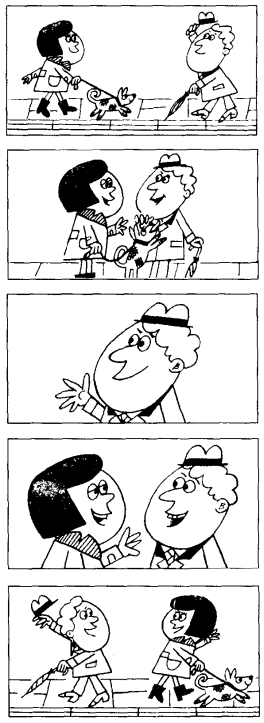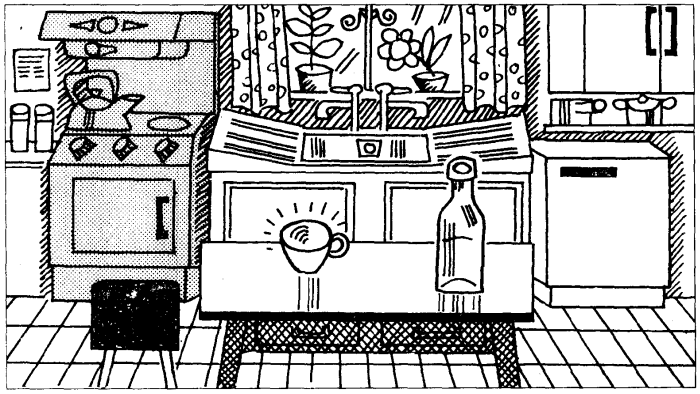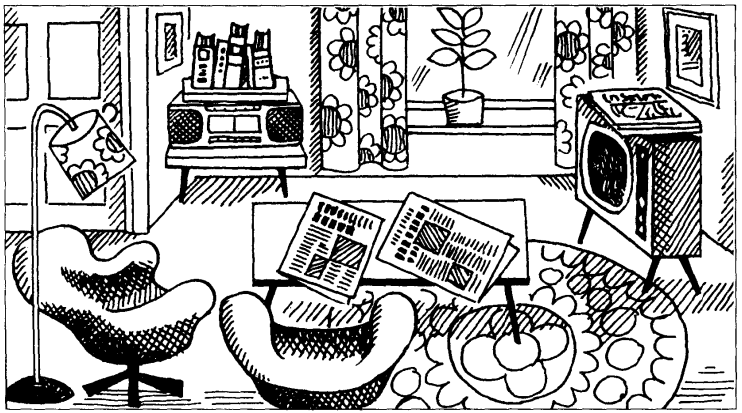Lesson 1~2
✨课文

✨单词
⚡本课重点
be动词:是系动词中的一种,前期先记住以下三种变化形式
am,只能跟在第一人称单数I后面,例如 I am a student.is,跟在第三人称单数he、she、it等后面,例如 She is a girl.are,搭配you使用,不管是单数还是复数,例如 You are a girl too.
主系表结构:通常由主语+谓语+表语构成,其中谓语动词通常是由系动词来充当,常用来表达什么是什么或什么怎么样
- e.g. He is a teacher.
he是主语,is是谓语,a teacher是表语 - e.g. The sky is blue.
the sky是主语,is是谓语,blue是表语
一般疑问句:通过主谓倒装可将带有be的陈述句变为一般疑问句,即将be的适当形式移至主语之前
- e.g.
He is a teacher.=> Is he a teacher? 把be动词提到主语he的前面
Lesson 3~4
✨课文

✨单词
⚡本课重点
巩固主系表结构,掌握含有be动词的简单陈述句
肯定句
- e.g. This is my umbrella.
否定句:与肯定陈述句相反,它表示「否定」涵义,并且含有一个如not之类的否定词。当含有be动词的句子如果变为否定句,就是在be动词的后面加上not
- e.g. This is not my umbrella.
针对一般疑问句的否定简答语是No, it's not.或No, it isn't.
祈使句:用来表达命令、要求、请求或劝告等,它的主语是you(即听的一方),但通常不显示说明
结构:动词原形+名词(代词)
- 以动词原形开头的句子,或在动词原型前面加
do(只限于省略第二人称主语的句子)的句子,都是祈使句,Open the window, please. - 以
let开头的句子也是祈使句,Let's go shopping.
倒装句:be动词放在here的后面,就可以成为简单的倒装句式
- e.g. Here is my umbrella.
其他补充:习惯用语,it suits me
Lesson 5~6
✨课文

✨单词
⚡本课重点
选择疑问句:含有or的疑问句称为选择疑问句。选择疑问句的回答必须要用完整的句子,选择疑问句的语调为前升后降。or连接的两个并列成分可以是状语、宾语、表语、谓语或是两个分句
- e.g. Is she German or Swedish?
不定冠词a和an:
a和an具有不确定的意思a和an只能用于单数可数名词的前面a用于辅音音标的普通名词之前,发音为/ə/an用于元音音标的单词之前,发音为/ən/
e.g. This is a B/C/D/G/J/K/P/Q/R/T/U/V/W/Y/Z、This is an A/E/F/H/I/L/M/N/O/S/X
称呼的用法:
- Mr. (未知)
- Mrs. (特指已婚女士)
- Miss (特指未婚女士)
- Ms. (未知)
根据经验,大部分情况下使用Mr.和Miss就行
Lesson 7~8
✨课文

✨单词
特殊疑问句
⚡本课重点
特殊疑问句:以特殊疑问词引导的问句都叫特殊疑问句。与一般疑问句的区别在于特殊疑问句不可以用yes或no回答
结构为: 特殊疑问词+助动词+主语+实义动词 或者是 特殊疑问词+一般疑问句(去掉答案)
| what | when | which | why | where | how | who | whom | whose |
|---|---|---|---|---|---|---|---|---|
| 什么 | 何时 | 哪一个 | 为什么 | 哪里 | 如何 | 谁 | 谁(宾格) | 谁的 |
too和either:两者都表示「也」的意思,too一般用于肯定句,either用于否定句和疑问句,它们一般都是放在句尾,且前面通常用逗号隔开
询问国籍:What nationality are you? 等价于 Where are you from?
Lesson 9~10
✨课文

✨单词
⚡本课重点
how引导的特殊疑问句
- e.g. She's very well today. => Is she well today? => How's she today?
先把陈述句中的be动词提到句首得到一般疑问句,再用how对一般疑问句中的答案well进行提问,并将how提到句首
形容词:形容词用来修饰名词,表示人或事物的性质、特征。通常可将形容词分为「性质形容词」和「叙述形容词」,其位置不一定都放在名词的前面。英文的形容词用法和中文语境中的用法是保持一致的
- 直接说明事物的性质或特征的形容词是「性质形容词」,它有级的变化,可用程度副词进行修饰,在句中可作定语、表语和补语
- 「叙述形容词」只能作表语,所以又称为表语形容词。这类形容词没有级的变化,也不能用程度副词进行修饰,大多数以
a开头的形容词都属于这一类 - 形容词作定语修饰名词时,要放在名词的前面。但是形容词修饰以
thing结尾的词语时,可放在这些词的后面
Lesson 11~12
✨课文

✨单词
⚡本课重点
whose引导的特殊疑问句
- e.g. This is her dress. => Is this her dress? => Whose dress is this?
先把陈述句中的be动词提到句首得到一般疑问句,再用whose对一般疑问句中的答案her进行提问,并将whose提到句首
名词所有格:在词尾加's构成,在句中不仅可以作定语,还可以作表语;如果是复数名词时,直接在词尾s加上'即可
- e.g. John's dog.
Lesson 13~14
✨课文

✨单词
⚡本课重点
what引导的特殊疑问句
- e.g. Her new dress is green. => Is her new dress green? => What colour is her new dress?
先把陈述句中的be动词提到句首得到一般疑问句,再用what对一般疑问句中的答案green进行提问,并将what提到句首
is it连读:it要失去爆破,发音类似/isit/
smart:通常所表达的意思是「聪明」,而不是「漂亮」
Lesson 15~16
✨课文

✨单词
名词复数规则变化
⚡本课重点
名词的单/复数:英语中的可数名词有「单数」和「复数」两种形式。表示一个人或事物时用单数形式,表示多个人或事物时用复数形式。
名词的复数规则变化
①一般情况下在词尾直接加
-se.g. book => books、pen => pens
②以字母
s、z、x、ch、sh结尾的单词,在词尾直接加-es,读/iz/e.g. watch => watches、fish => fishes、box => boxes
③以辅音字母加
y结尾的单词,将y改为i,再加-es,读/z/e.g. country => countries、family => families
④以元音字母加
y结尾的单词,在词尾直接加-s,读/z/e.g. day => days、monkey => monkeys
⑤以
ce、se、ze、(d)ge结尾的单词,在词尾直接加-s,读/iz/e.g. bridge => bridges、blouse => blouses
⑥以
f、fe结尾的单词,将f或fe改为ves,读/vz/e.g. knife => knives、thief => thieves
⑦以
o结尾的单词一般加-s,部分以辅音字母加o结尾的单词,在词尾直接加-es,读/z/e.g. zoo => zoos、tomato => tomatoes
⑧以
ix结尾的单词,一般将ix改为ices⑨以
um结尾的单词,将um改为a⑩以
a结尾的单词,在词尾直接加-e
如果句中的主语是名词的复数形式或复数的人称代词时,则句中的be动词要用其复数形式are
- e.g. This is a book.、These are my books.
be动词的一般现在时:英语中的be动词在使用时有人称的变化,在口语中这些变化常用缩略形式
| 肯定句 | 肯定的缩略 | 否定的缩略 |
|---|---|---|
| I am | I'm | I'm not |
| You are | You're | You're not = You aren't |
| He is | He's | He's not = He isn't |
| She is | She's | She's not = She isn't |
| It is | It's | It's not = It isn't |
| We are | We're | We're not = We aren't |
| They are | They're | They're not = They aren't |
Lesson 17~18
✨课文

✨单词
⚡本课重点
who引导的特殊疑问句
- e.g. This is young man Jandan. => Is this young man Jandan? => Who is this young man?
先把陈述句中的be动词提到句首得到一般疑问句,再用who对一般疑问句中的答案Jandan进行提问,并将who提到句首
可数名词复数的发音规则
原词尾发音是清辅音的(除
/s/、/∫/、/t∫/),-s读/s/e.g. books、cooks、suits
原词尾发音是元音或浊辅音的(除
/z/、/ʒ/、/dʒ/),如/b/、/d/、/g/等,-s读/z/e.g. ties、birds、bags
原词尾发音是
/s/、/∫/、/t∫/、/z/、/ʒ/和/dʒ/,-s读/iz/e.g. dresses、dishes、blouses
Lesson 19~20
✨课文

✨单词
There be
⚡本课重点
There be结构:此结构可将重要的新信息置于句末,以示强调
这种句子结构中的there是个引词,本身没有实际意义,常弱读。句子中的be为谓语动词,be后面的名词为实际主语,句子最后部分为地点(时间)状语
肯定句:表示某处有某物,类似中文的
有什么。There am/is/are+名词(+地点(时间)状语)e.g. There is a pen.
否定句:要在
be的后面加上not即可,类似中文的没有什么。There am/is/are+not+名词(+地点(时间)状语)e.g. There isn't a pen.
疑问句:只需将
be提到句首(there前面)即可,类似中文的有什么吗。Am/Is/Are there+名词(+地点(时间)状语)e.g. Is there a pen?
特殊疑问句:在一般疑问句的句首加上特殊疑问词并去掉答案。
特殊疑问词+am/is/are there(+地点(时间)状语)e.g. There is a pen. => There isn't a pen. => What is there?
先把陈述句中的
be动词提到句首得到一般疑问句,再用what对一般疑问句中的答案pen进行提问,并将what提到句首
Lesson 21~22
✨课文

✨单词
⚡本课重点
which引导的特殊疑问句:用来询问事物或性质,需要从限定的、特指的范围中做出选择
- e.g. This is my book. => Is this your book? => Which is your book?
先把陈述句中的be动词提到句首得到一般疑问句,再用which对一般疑问句中的答案this进行提问,并将which提到句首
不定代词one:用来代替前文出现过的人称代词或可数名词,以免重复。它有复数形式ones,可以和冠词连用,也可以有自己的定语
one、that和it之间的区别:one表示泛指,that和it表示特指,that与所指的名词为同类,但不是同一个,而it与所指的名词是同一个
Lesson 23~24
✨课文

✨单词
双宾语
⚡本课重点
双宾语:有些动词可以有两个宾语,往往一个指代人,一个指代物。指人的叫「间接宾语」,指物的叫「直接宾语」
间接宾语一般放在直接宾语的前面,人要用代词的宾格。
give sb. sth.e.g. give me money
如果直接宾语是个人称代词时,就需要在间接宾语的前面加上介词
to,并把这个带to的间接宾语放在直接宾语的后面。give sth. to sb.e.g. give it to me
give sb. sth.等价于give sth. to sb.,两者是同义结构,可以相互转换当直接宾语是名词时,它既可以放在间接宾语的后面,也可以在间接宾语的前面加
to,并把这个带to的间接宾语放在直接宾语的后面
where引导的特殊疑问句:
- e.g. My book is on the shelf. => Is my book on the shelf? => Where is my book?
先把陈述句中的be动词提到句首得到一般疑问句,再用where对一般疑问句中的答案on the shelf进行提问,并将where提到句首
介词on:经常用在名词、名词短语、代词或动名词的前面,用来表示人物、事件等之间的各种关系,如空间关系、时间关系、因果关系等。介词始终带有宾语,即使介词与宾语之间分隔开时,这种关系仍然存在
介词短语:介词+名词(+介词)
- e.g. on time、in the middle of
介词不能在句子中独立充当一个成分,需要和一个名词或与之相当的词构成介词短语来充当句子中的一个成分,和介词构成短语的那个部分称为「介词的宾语」
on在不同的搭配情况下有不同的含义
在一个平面或线上
e.g. on the table
在某一个不精确的时间
e.g. on Monday
Lesson 25~26
✨课文

✨单词
⚡本课重点
介词in:表示「地点、场所、部位」等,它的用法很多,本课学习的是其「在…里面」的意思
在某范围或空间内
e.g. There is a refrigerator in the kitchen.
在某一段时间内
e.g. in the morning
定冠词the:表示特指,不论是指人、物、单数、复数,其形式都不会发生变化。与指示代词this和that同源,有「这(那)个」的意思,但较弱,可以和一个名词连用,来表示某个或某些特定的人或物。
场景的使用场景如下
- 特指双方都明白的人或物
- 前文提到过的人或物
- 世上独一无二的事物
- 与单数名词连用时表示一类事物;与形容词、分词连用时表示一类人
- 用在数词、形容词最高级、
only、very、same等前面 - 与复数名词连用时表示整个群体
- 用在身体部位的名词前面时,相当于物主代词,表示「所有」
- 用在某些由普通名词构成的国家名称、机关团体、阶级等专用名词前面
- 用在表示乐器的名词前面
- 用在姓氏的复数名词前面,表示一家人
- 用在惯用语中
the在元音前读/ði/,e.g. the engineer
the在辅音前读/ðə/,e.g. the floor
Lesson 27~28
✨课文

✨单词
⚡本课重点
how many引导的特殊疑问句:用来询问数量
- e.g. There are two books on the desk. => Are there two books on the desk? => How many books are there on the desk?
先把陈述句中的be动词提到句首得到一般疑问句,再用how many对一般疑问句中的答案two books进行提问,并将how many提到句首
some和any的区别:在英语中,some和any是两个最常用的数量词,它们都表示「一些」。再具体一点话some表示「某些」,any表示「任一」
some:修饰可数名词复数和不可数名词,表示「某些」但不是「全部」,通常用于肯定句。在疑问句中,所希望的回答是yes时也可以用someany:表示「任一」,即不确定的数量,通常用于否定句和疑问句
Lesson 29~30
✨课文

✨单词
情态动词must
⚡本课重点
情态动词:是一种本身没有词义,表示说话人的语气和情态的助动词。
- 它不能单独做谓语,只能和后面的动词原形一起构成谓语动词
- 它没有人称和数的变化
- 含有情态动词的句子,否定句和疑问句都是在情态动词上发生变化
情态动词must:单词本义为「必须」。它必须与其他东西连用,没有时态、人称和数的变化
肯定句:表示必须做某事。
主语+must+V.(+其他)e.g. I must drink some water.
否定句:只需在
must的后面加上not即可。其否定形式表示「禁止」而不是简单的非必须,语气强烈,不要随便使用。主语+must not+V.(+其他)e.g. You mustn't smoke here.
一般疑问句:只需将
must提到句首(主语前面)即可。Must+主语+V.(+其他)e.g. Must I do the homework today?
特殊疑问句:在一般疑问句的句首加上特殊疑问词并去掉答案。
特殊疑问词+must+主语+V.(+其他)e.g. I must drink some water. => Must I drink some water? => What must I do?
先把陈述句中的
must提到句首得到一般疑问句,再用what对一般疑问句中的答案drink some water进行提问,并将what提到句首